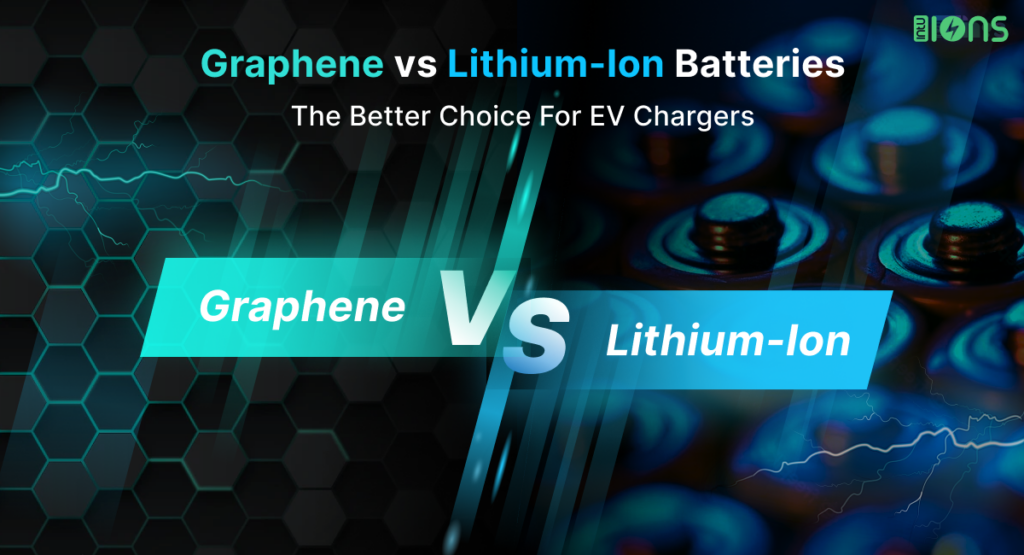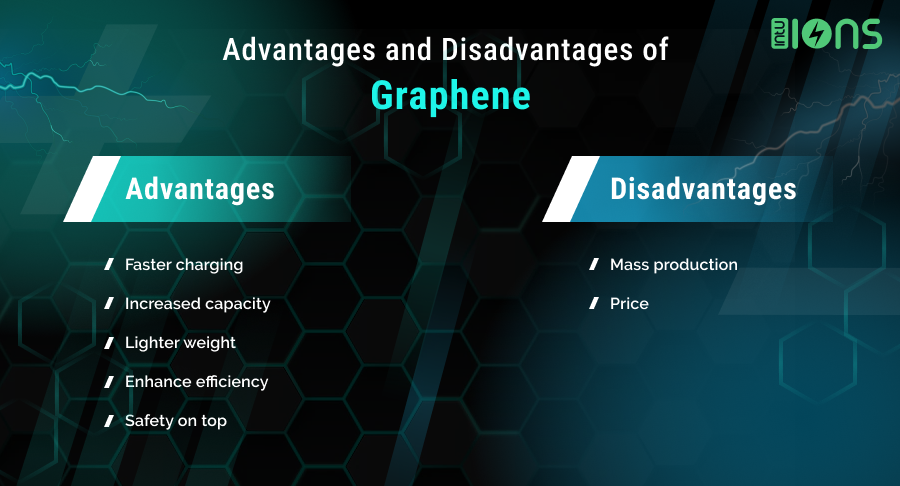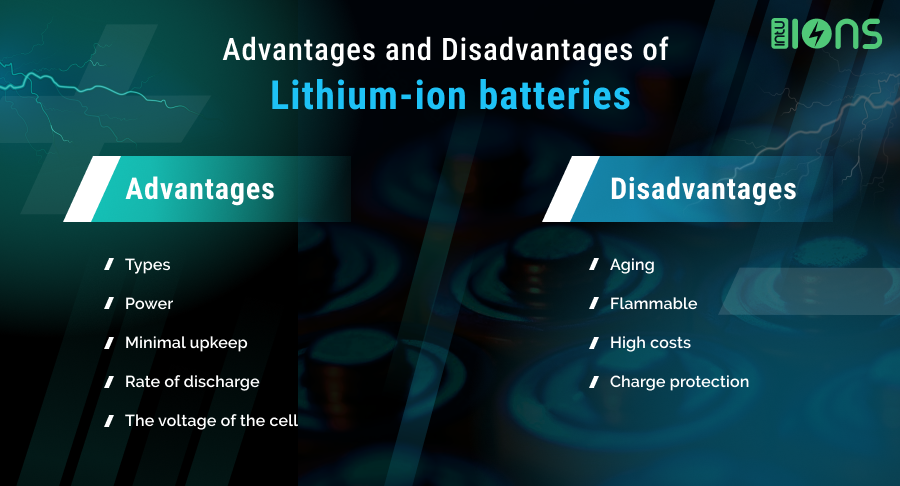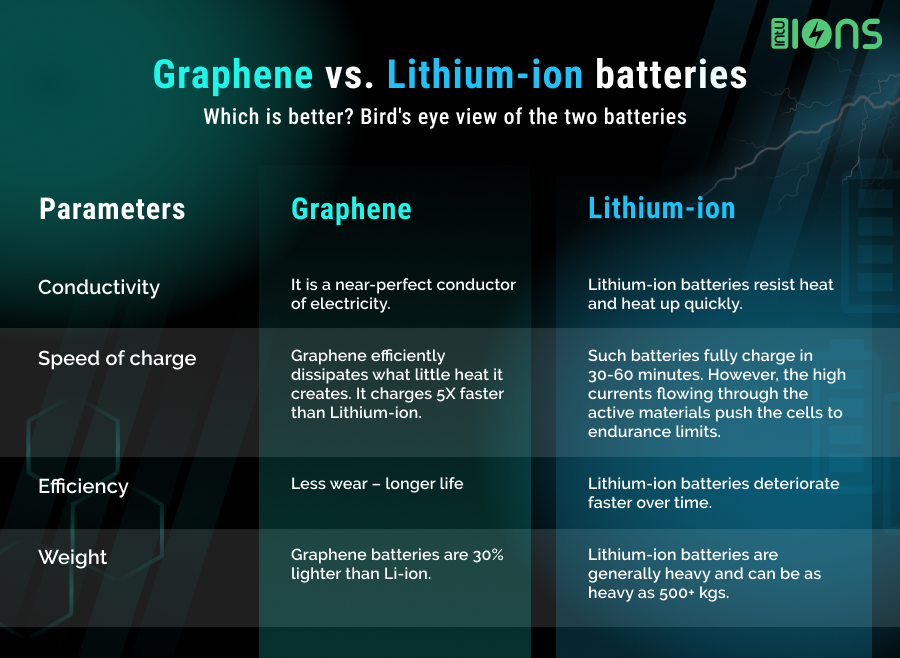Graphene vs Lithium-Ion Batteries: The Better Choice For EV Chargers

As electric cars run on batteries, there is always confusion about the best battery option. Sure, there is Lithium-ion. But it has disadvantages that do not make its adoption worth it. Graphene, however, shows a lot of promise in the market. This article does a detailed analysis of both Graphene vs Lithium-ion batteries for EVs:
Energy storage solutions such as batteries play a vital role in the functioning of Electric Vehicles (EVs), including hybrid and plug-in hybrid models. Ultracapacitors, Lithium-ion batteries, and lead-acid batteries are majorly used to power EVs.
Amongst these options, Lithium-ion batteries are most extensively used in EVs because of their high power-to-weight ratio, excellent energy efficiency, optimal energy ratio per weight, and good performance at high temperatures compared to alternative energy storage solutions.
Think of it like this – a lighter car battery results in greater mileage with a single charge. But there is one huge disadvantage of using Lithium – the battery production costs are high, and the temperature achieved during operation often reduces the battery life considerably.
That is why the focus has shifted to making Graphene batteries as energy storage solutions for EVs in the last few years. Such batteries charge extremely rapidly and deliver a long driving range. But should we altogether remove Lithium-ion batteries from the list? Is Graphene the future in the world of EVs? Let us do a comparative analysis:
What are Graphene batteries?
In the two-dimensional (2D) structure of Graphene, the carbon atoms are arranged flatly to form hexagonal rings that resemble honeycombs. The structure is only one atom high, yet it is one of the most intriguing discoveries in recent memory because of its characteristics. Although Graphene is incredibly thin, light, and nearly transparent, it has earned a reputation for being more durable than diamond and steel.
It is extremely durable and a fantastic electrical conductor. The flat hexagonal form makes it easier for electrons to flow with minimum resistance, delivering greater electrical and heat conductivity better than the most conductive metal, Copper.
Since Graphene exhibits exceptional conductivity at ambient temperature alone, it is one of the ideal materials for developing next-generation batteries. It does not require any particular circumstances to achieve the same.
Graphene offers several advantages over traditional Lithium-ion batteries. Its unique structure gives remarkable properties such as high electrical conductivity, optimal thermal conductivity, and unabashed strength.
Advantages and disadvantages of Graphene Batteries
Graphene batteries are a relatively new technology, but that does not mean they have not been put to the test. Manufacturers spend a lot of time researching Graphene batteries, which makes sense given how much better they are than the Lithium-ion batteries we currently use.

Advantages of Graphene batteries:
1. Faster charging
Due to the honeycomb structure’s lack of resistance to the flow of electrons, Graphene is a powerful conductor of electrical energy. Compared to Lithium-ion batteries, they can charge quickly and offer longer battery life.
2. Increased capacity
When compared to Lithium-ion batteries, Graphene has a higher energy density. The former is known to store up to 180 Wh per kilogram, while Graphene can store up to 1,000 Wh per kilogram. Consequently, a Graphene battery pack with a larger capacity – the same size as a Lithium-ion battery – is possible.
3. Lighter weight
Graphene is lightweight, and you achieve 1 mm thickness when you build 3 million layers of Graphene. It shows that Graphene batteries would not occupy much room in a device. It will enable manufacturers to put larger batteries in your phones, tablets, laptops, and other devices.
4. Enhance efficiency
Graphene also helps with greater heat dissipation. It is an advantage for regularly used devices. For instance, your phone will not become hot when charging or playing games because it can lower the battery’s operating temperature by up to five degrees.
5. Safety on top
Since Graphene is a more flexible and robust material than Lithium-ion, it is anticipated that Graphene batteries will be much safer than Lithium-ion batteries. This implies that upcoming battery packs will not require a lot of protective casings, taking up less space and being lighter.
What are the disadvantages of Graphene?
These batteries have a variety of advantages, but there is a reason why their widespread adoption in modern devices is happening slowly. The primary cons of using Graphene is that it is susceptible to oxidative environments. Moreso, toxic chemicals are used at high temperatures to manufacture Graphene. Here are two more reasons:
1. Mass production
There is no practical method for producing high-quality Graphene in large quantities. You could make Graphene at home with graphite and adhesive tape, but it would not be suitable for mass production. Lack of the same increases manufacturing costs because higher quality materials may cost between tens and thousands of dollars.
2. Price
Continuing from the first point – typical conductive carbon/graphite is incredibly affordable. In contrast, Graphene is too pricey and is sold per tonne. The cost of a gram is thousands of dollars, which is beyond the means of common businesses. A few years ago, Graphene cost much more than gold, making it unaffordable for the average customer.
The Graphene manufacturing process is still in its infancy and cannot be scaled up. Although Graphene batteries have these drawbacks, they are dependable and quick to charge.
The commercialization of Graphene batteries: Top use cases
Many firms are now testing graphene batteries, and efforts are being made to upgrade Lithium batteries with Graphene. They will help improve the performance of devices, although they are not yet entirely commercially available:
1. Research on Graphene by Samsung
The battery division of the Korean behemoth, Samsung SDI, is intensively researching this area and has made numerous advancements in recent years. First, we discovered that Samsung had created “Graphene balls” that could extend the life of Lithium-ion batteries.
Except for a few appearances at auto and electronics expos, Samsung has since kept quiet about its aspirations for Graphene batteries. However, there have been reports that Samsung is developing a revolutionary smartphone powered by a Graphene battery that has yet to be unveiled. These batteries are supposed to charge entirely in half an hour and function at high temperatures of 60 degrees.
2. Additional research and OEMs
Many battery manufacturers, including CellsX, are already producing and delivering Graphene batteries to their partners and Samsung. They have created larger batteries for model quadcopters and EVs in addition to smaller battery packs for power banks. To provide longer working times and aid in heat dissipation, Huawei also revealed a Graphene-enhanced Lithium-ion battery in 2016.
While Graphene batteries are yet to emerge in our phones, you could still use a power bank with these batteries to charge them. Yes, there are a few Graphene battery power banks on the market. These power banks, Apollo and Ultron, used crowdsourcing to raise funds for manufacturing and shipping purposes.
On the other hand, well-known electric vehicle manufacturers Tesla and India’s Log9 are expressing interest in metal-air batteries. Since Graphene is porous and allows air to pass through, a Graphene rod is used as the cathode in these processes. It sounds impressive that metal-air batteries can help improve battery efficiency by up to 5X at a third of the cost.
What are Lithium-ion batteries?
Lithium-ion is the most popular battery used in everyday devices like portable electronics, including laptops, cell phones, and EVs. The superior power-to-weight ratio, high energy efficiency, and exceptional high-temperature performance are all characteristics of Lithium-ion batteries.
Li-ion batteries have a high energy-to-weight ratio. The feature makes electric cars lighter and allows them to drive farther on a single charge. They are also better than conventional batteries at maintaining their capacity to hold a full charge over time because they have a low “self-discharge” rate.
Furthermore, most Lithium-ion battery components are recyclable, making these batteries a suitable option for those who care about the environment. Although the specific chemistry of these batteries differs from that utilized in consumer devices, they are employed in All-Electric Vehicles (AEVs) and Plug-in Hybrid Electric Vehicles (PHEVs).
Lithium-ion batteries are one of the best forms of rechargeable batteries that have been in demand and manufactured for more than 20 years. They are a superior and more potent option than the well-known nickel-cadmium ones because of their high energy density.
Lithium-ion batteries comprise the following: first off, it has a cathode that controls the product’s voltage and capacity. It is where the positively-charged Lithium-ions come from and where they are first formed. The anode facilitates and permits the flow of electrical current through the batteries via and from an external circuit. The Lithium-ions stay here even after the battery has been fully charged.
The electrolyte is the third element in Lithium-ion batteries. Solvents, salts, and additives make up this mixture. The ions can flow between the anode and the cathode thanks to the electrolyte’s role as a conduit. The batteries also include a separator. It functions as a physical barrier and a means of keeping the two charged electrodes apart.
Advantages and disadvantages of Lithium-ion batteries
For starters, they offer improved discharge and charge efficiency compared to lead-acid and other Lithium batteries. You can expect your battery to run longer and leverage the ability to discharge and recharge while maintaining power.

What are the Advantages of Lithium-ion batteries?
For starters, they offer improved discharge and charge efficiency compared to lead-acid and other Lithium batteries. You can expect your battery to run longer and leverage the ability to discharge and recharge while maintaining power. There are several other advantages to using Lithium-ion batteries, some of which are as follows:
1. Types
Lithium-ion batteries are efficiently and effectively used in various applications and are available in different types and sizes. They are suited for various device kinds and have unique power needs.
2. Power
Lithium-ion batteries have a higher energy density than other batteries of the same type. They can provide up to 150 watt-hours of energy per kilogram. In contrast, lead-acid batteries only provide 25 WH/kg, and nickel-cadmium batteries provide roughly 60–70 WH/kg.
3. Minimal upkeep
Lithium-ion batteries require little to no maintenance to function. They do not need routine or extra care, like priming.
4. Rate of discharge
Only 5% of the stored or accumulated charge is lost each month by Lithium-ion batteries, which have a low discharge rate. They can, therefore, last longer between two charging sessions because they have stronger and more reliable charging capabilities. Other comparable products report monthly losses of up to 20%.
5. The voltage of the cell
A voltage of roughly 3.6V can be generated by each Lithium-ion battery cell. It is higher than other varieties that only provide 1.5 to 2 volts. It suggests that the power management of Lithium-ion batteries is improved and made more straightforward.
What are the disadvantages of Lithium-ion batteries?
Lithium-ion batteries age faster and lose their capacity to deliver what they should provide. Their adoption costs are high, which does not make them a worthwhile investment in the long run. Like all other things, Lithium-ion batteries have their share of shortcomings. They consist of the following:
1. Aging
Lithium-ion batteries have a limited lifespan even though they survive longer than other batteries of their class. Before failing, they can only tolerate use for 500–1000 charge and discharge cycles. Even when the batteries are not in use, they do not stop aging.
2. Flammable
Lithium-ion batteries contain flammable electrolytes, which can cause small-scale flames when overheated.
3. High costs
Due to higher production and manufacturing costs, Lithium-ion batteries are almost 40% more expensive than nickel-cadmium batteries.
4. Charge protection
Lithium-ion batteries are comparatively less durable than other rechargeable batteries. They must be shielded from overcharging, overheating, and total discharge. They require a shielding circuit to keep the current and voltage within the acceptable range and regulations.
Graphene vs. Lithium-ion batteries: Which is better?
Graphene cells utilize two conductive plates coated in a porous substance and submerged in an electrolyte solution, just like Lithium-ion (Li-ion) batteries do. The two batteries offer different qualities, although having very similar internal structures.
1. Electrical conductivity
In comparison to Lithium-ion batteries, Graphene has better electrical conductivity. This makes it possible for cells to deliver very large currents while also charging quickly. For example, quick device-to-device charging or high-capacity automotive batteries can benefit from this. High heat conductance also makes batteries run cooler, preventing heating and extending their life even in minor cases like smartphones.
2. Weight
Compared to current Lithium-ion cells, Graphene batteries are also lighter and thinner. This entails slimmer, more compact gadgets or batteries with higher capacities that do not require additional space. In addition, Graphene accommodates substantially larger capacities. Graphene can store up to 1,000Wh of energy per kilogram, whereas Lithium-ion can only store up to 180Wh.
3. Safety
Graphene has a five times higher energy density than a typical Li-ion battery. Finally, Graphene is safer. Although Lithium-ion batteries have a relatively high safety record, there have been a few significant occurrences involving defective goods.
Runaway chemical imbalances in li-ion batteries can result in fires due to overheating, overcharging, and puncturing. Graphene is significantly more resistant to such problems and much more stable, flexible, and strong. Here is a bird’s eye view of the two batteries:

Is Graphene better than Lithium-ion for EVs?
Graphene or Lithium-ion – you are not required to have either one or the other. Graphene can improve the cathode conductor performance in Lithium-ion batteries. These are referred to as Graphene-metal oxide hybrids or Graphene-composite batteries.
Compared to today’s batteries, hybrid batteries are lighter, charge more quickly, have more storage space, and last longer. Among the various Graphene-based battery technologies and varieties, Graphene Lithium-ion batteries are anticipated to be used in 1-3 years, solid-state batteries in 4–8 years, and Graphene supercapacitors in 10 years.
They are less expensive and easier to recycle than Lithium-ion batteries. Sodium and aluminum are more prevalent than Lithium; Graphene sodium-ion and Graphene aluminum-ion batteries have the potential to replace Lithium-ion batteries.
Over to you
Future EVs may use Graphene aluminum-ion batteries as their primary power source because they can charge 60 times quicker than Lithium-ion batteries and store a lot more energy than pure aluminum cells. For instance, Graphene aluminum-ion cells can recharge an AA battery in a minute and a coin-cell battery in under ten seconds.
Graphene, which boasts of the highest electrical conductivity of any known substance, is the battery of the future for electric cars. Batteries made of Lithium, sodium, and aluminum can all benefit from the use of Graphene.
Graphene is one of many technologies that will be used in EV batteries in the future, but despite its drawbacks, it looks the most promising. It is believed Graphene EV batteries will eventually replace Lithium-ion thanks to research, innovation, and massive funding.
If you want to build an end-to-end solution for EVs and need tech experts for help, drop us a message to get in touch.
